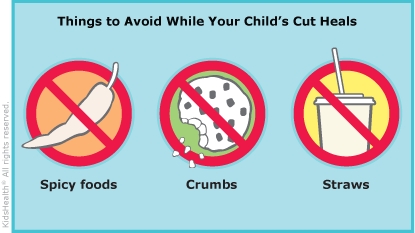Lip Cut Fixed With Stitches: How to Care for Your Child
Cuts can happen on the outside or inside of the lip. Health care providers sometimes use stitches to close a lip cut and help it heal. Some stitches dissolve on their own, but others need to be removed. A healing cut can get infected, so the health care provider cleaned it carefully. You can help to prevent infection by taking good care of the cut as it heals.


-
You can give medicine for pain if your health care provider says it's OK. Use these medicines exactly as directed:
-
Offer soft foods that are easy to eat.
-
Avoid foods that:
-
Have your child rinse the mouth with water after snacks and meals.
-
Don't pull on the lip to check the stitches or pick at scabs that form. This can cause bleeding.
-
If your health care provider recommends it, spread a thin layer of antibiotic ointment over the cut as directed.
-
If your child has stitches that need to be taken out, go to the health care provider as directed to have them removed. Leaving the stitches in place too long may cause more scarring.
-
Make sure your child's tetanus vaccine is up to date.

-
Your child has redness, warmth, or swelling around the wound. This could be the start of an infection.
-
Pus drains from the wound.
-
Your child has a fever.


What should I expect as the cut heals? Slight redness or itchiness around the cut is normal. A small amount of bloody or clear fluid may ooze from the wound and dry to form a scab, which will eventually fall off. Most cuts will leave a small scar.
Why does a cut get a scar? When the deeper layer of the skin is injured, the body uses a protein (collagen) to help fill in the cut area. The filled-in area becomes a scar. A scar can form even if a cut is fixed with stitches. Over time, some scars fade or get smaller.